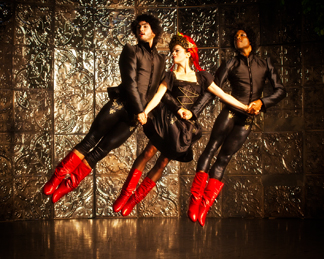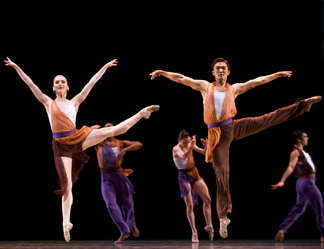Spain and the Ballets Russes
 Photo of Company XIV in the Russian Dance from Snow White. Dancers from L. to R. are Austin McCormick, Laura Careless and Davon Rainey. Photo by Daniel Perez. |
By DAWN LILLE
ART TIMES Mar/ Apr 2010
Flamenco
A program note on the history of flamenco, which is composed of equal parts of song, dance and music, points out that Andalucia, in southern Spain, has received many different peoples. Romans, Jews, Moors and, in the 15th century, tribes of nomadic Gypsies arrived there. The historian Felix Grande, writing about life in the 15th, 16th and 17th centuries, said:
The Jews were massacred, the Gypsies humiliated and persecuted, the Arabs exterminated, the Moriscos (converted Arabs) expelled, and the Andalucians generally exploited… if we do not relate the music… to the brutality, repression, hunger, fear, menace, inferiority, resistance, and secrecy, then we shall not find the reality of cante flamenco… it is a storm of exasperation and grief.
When this background, from which flamenco evolved, is realized, the complexity, mystery and passion of the form is more easily understood and one stops looking for smiles.
In the program presented by Soledad Barrio and the company Noche Flamenco, which consists of Ms. Barrio, two singers, three guitarists and three male dancers, one was struck by the complicated staccato footwork and the contrast between the impassioned movement and the equally impassioned stillness. The epaulement, or movement of the entire upper torso/shoulder region, performed in opposition to the deliberate head movements, could be interpreted as menacing. But seen together they projected an inner pain and pride.
Of the two male soloists Antonio Jimenez, who danced a Solea por Bulerias, is introspective and the tall Juan Ogallo, in his Alegrias, strongly defiant. Ogallo has a face like those of the presidents carved on the western rocks. Occasionally his determination to communicate his feelings to the audience was overdone, but it was as though he was constructing an edifice hand in hand with the singers and musicians, the sounds and sights melding together. Barrio appears to have an inner volcano, what in flamenco is sometimes called a duende or demon, and between her powerful torso, explosive feet and arms that float, yet control the air, one is carried to another level. Her solo, Soleo, left every member of the audience motionless. It was New Year’s Eve and the experience was exhilarating.
Ballet
Peter Boal was an elegant, intelligent and much loved principal with the New York City Ballet who retired in 2005 to become artistic director of Pacific Northwest Ballet, based in Seattle. Its recent appearance at the Joyce Theater, the first in New York since Boal took over, was sold out. Although only half the company came east (the Joyce stage is too small to accommodate the entire troupe), it is obvious they are strong, clean dancers with no mannerisms, who project joy in their art.
 Pacific Northwest Principal dancers Carla Korbes and Batkhurel Bold with company members in Tharp's Opus III. Photo: Angela Sterling |
The two main works on the program were choreographed specifically for the company by Twyla Tharp and Benjamin Millepied. Opus III, Tharp’s ballet, which received its New York premiere, is set to the ” String Quartet in G Major” by Brahms. The four movements utilize five dancing couples. And what dancing!
At times the dance was reminiscent of the Tharp of long ago – the loose torso, the jutting hip, the shrug of the shoulders. The bodies are open, led by wide, far reaching arms and the dancers flowed through space, using it up and creating more. The shapes were organic in that the movement was often like the tiny sponges you put in water and watch as they grow and spread, yet still retain their shape. Tharp also picked up on the folk elements in the music.
I have often thought of her in connection with the old rhyme “When she was good she was very, very good and when she was bad…” She was very good and this is a work I would like to see again.
Benjamin Millepied is a principal dancer with the New York City Ballet, for which he has choreographed several pieces. Additionally he has created works for other companies world-wide. His ballet 3 Movements, to Reich’s “Three Movements for Orchestra,” also received its New York premiere.
A well crafted work for sixteen dancers dressed in black, gray and white, against a set of the same colored panels, it used this refreshing company well. But sometimes there were too many themes, which made it difficult to see clearly the structure of the ballet. This piece, by a promising young choreographer, could use more breathing space but he has mastered his craft well.
Modern Baroque
Austin McCormick, whose Company XIV presented three works called The Apple Trilogy in repertory from December 5 through January 17, is a young and amazing talent. He is capable of imagining a production, writing a script, selecting music, choreographing the movement, choosing excellent dancers, actors and designers to carry out his vision and directing each production down to the most minute detail. The resulting dance dramas, where lighting, design and music are as important as dance and drama, are rich and luscious in their look and feel and are quintessentially theatrical.
I had seen Le Serpent Rouge (Adam, Eve, Lilith and that apple of knowledge) and Judgment of Paris (Helen, Aphrodite, Paris and the golden apple) in previous seasons. Hence I was curious to see whether the Baroque-tinged, sometimes bawdy sensuality of these productions (McCormick, a Juilliard graduate, is also trained in the Baroque) would be seen in the new family show Snow White
The small theater in a converted garage on Bond Street in Brooklyn was filled with children and their parents on a cold Sunday afternoon. But the magnificence of the proscenium and curtain, part of the set design by Zane Philstrom, kept their attention before the performance, based on the Brothers Grimm tale, began.
For one hour the eye could not stop moving nor the ear stop listening. The sights included the seven dwarfs, represented by shadow puppets in the shape of French peasants, the Prince (McCormick) hopping up a tree to kiss Snow White (Yeva Glover) and the Queen (Gioia Marchese) talking to her mirror. The latter’s answer was sung by three women, the clear voiced opera trio Charities, made up of Brooke Bryant, Brett Umlauf and Amber Youell. The costumes by Olivera Gajic were opulent and at the same time tongue-in-cheek. The music ranged from Glazounov to Klezmer to Louis Armstrong to Bellini to the Mills Brothers, to name a few. The lighting by Gina Scherr was magical.
The dancing? The trio of Laura Careless, Davon Rainey and McCormick portrayed various people and objects, with innumerable costume changes. Dancing with a complete awareness of and reaction to each other, their ever changing movements were so artfully integrated into the drama that their technical ability never jumped out. One dance, where they were snow, was perfectly timed and very funny. The children loved it, as did their parents.
Every performer and every element in this company is excellent and the tale of Snow White is, thankfully, not without elements of sensuality.
Email your response to this and other essays in ART TIMES info@ArtTimesJournal.com
